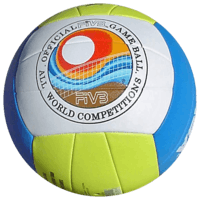Sports
Sports are activities involving physical exertion and skill in which an individual or team competes against another or others for entertainment.
Generally, all sports may be played by men, women, and children.
Football
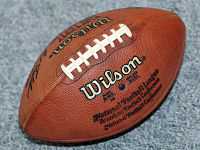
Def. "a game in which two teams attempt to get an ovoid ball to the end of each other's territory"[1] is called football, or American football.
In American football, as shown in the image on the right, a player may often carry the ovoid ball such as the one shown on the left into the end, or end zone, of the other team's territory.
Futbol
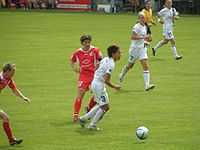
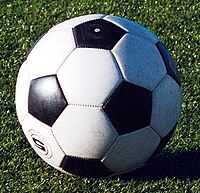
Def. "a game in which two teams each contend to get a round ball into the other team's goal primarily by kicking the ball"[1] is called football, futbol, or association football.
In the image Conny Pohlers (in red at the far left just entering the frame) follows-up on a pass before members of the opposing team (in white) may intercept.
On the left is an example of a futbol.
Tennis
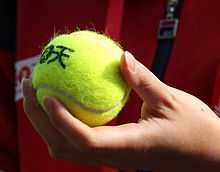
Def. a "sport played by two players (or four in doubles), who alternately strike the ball over a net using racquets"[2] is called tennis.
Shahar Peer (bottom) rallies with Anna Chakvetadze during the 2007 US Open, in the image on the right.
On the left is a tennis ball used at the 2011 Japan Open.
Volleyball

Def. a "game played on a rectangular court between two teams of two to six players which involves striking a ball back and forth over a net"[3] is called volleyball.
On the right, members of U.S. Armed Forces Women's Volleyball team block an Italian player from scoring during the 3rd Military World Games held in Catania, Sicily.
On the left is an example of a volleyball used in playing beach volleyball.
Research
Hypothesis:
- Many long-time sports have become dominated in some instances by taller and taller players at the expense of shorter but equally skilled players. Accordingly, modifications to these sports may create entertaining and engaging sports that are less height restrictive.
Control groups

The findings demonstrate a statistically systematic change from the status quo or the control group.
“In the design of experiments, treatments [or special properties or characteristics] are applied to [or observed in] experimental units in the treatment group(s).[4] In comparative experiments, members of the complementary group, the control group, receive either no treatment or a standard treatment.[5]"[6]
Proof of concept
Def. a “short and/or incomplete realization of a certain method or idea to demonstrate its feasibility"[7] is called a proof of concept.
Def. evidence that demonstrates that a concept is possible is called proof of concept.
The proof-of-concept structure consists of
- background,
- procedures,
- findings, and
- interpretation.[8]
See also
References
- 1 2 "football, In: Wiktionary". San Francisco, California: Wikimedia Foundation, Inc. 24 July 2015. Retrieved 2015-08-10.
- ↑ "tennis, In: Wiktionary". San Francisco, California: Wikimedia Foundation, Inc. 1 May 2015. Retrieved 2015-05-24.
- ↑ TheDaveRoss (25 April 2005). "volleyball, In: Wiktionary". San Francisco, California: Wikimedia Foundation, Inc. Retrieved 2015-05-24.
- ↑ Klaus Hinkelmann, Oscar Kempthorne (2008). Design and Analysis of Experiments, Volume I: Introduction to Experimental Design (2nd ed.). Wiley. ISBN 978-0-471-72756-9. http://books.google.com/?id=T3wWj2kVYZgC&printsec=frontcover.
- ↑ R. A. Bailey (2008). Design of comparative experiments. Cambridge University Press. ISBN 978-0-521-68357-9. http://www.cambridge.org/uk/catalogue/catalogue.asp?isbn=9780521683579.
- ↑ "Treatment and control groups, In: Wikipedia". San Francisco, California: Wikimedia Foundation, Inc. May 18, 2012. Retrieved 2012-05-31.
- ↑ "proof of concept, In: Wiktionary". San Francisco, California: Wikimedia Foundation, Inc. November 10, 2012. Retrieved 2013-01-13.
- ↑ Ginger Lehrman and Ian B Hogue, Sarah Palmer, Cheryl Jennings, Celsa A Spina, Ann Wiegand, Alan L Landay, Robert W Coombs, Douglas D Richman, John W Mellors, John M Coffin, Ronald J Bosch, David M Margolis (August 13, 2005). "Depletion of latent HIV-1 infection in vivo: a proof-of-concept study". Lancet 366 (9485): 549-55. doi:10.1016/S0140-6736(05)67098-5. http://www.ncbi.nlm.nih.gov/pmc/articles/PMC1894952/. Retrieved 2012-05-09.
External links
![]() This is a research project at http://en.wikiversity.org
This is a research project at http://en.wikiversity.org
| |
Development status: this resource is experimental in nature. |
| |
Resource type: this resource is an article. |
| |
Resource type: this resource contains a lecture or lecture notes. |
